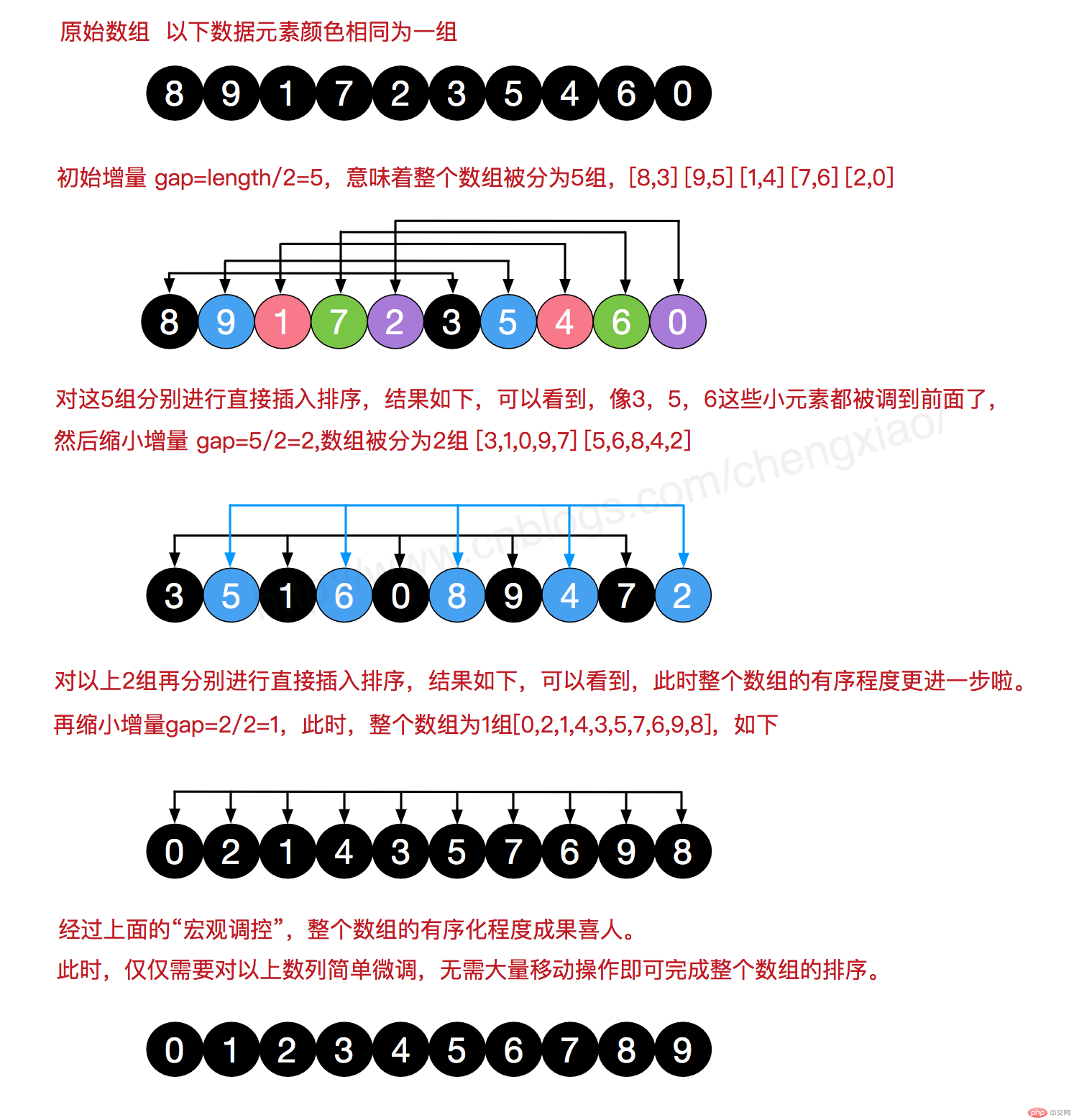 Operation and Maintenance
Operation and Maintenance
 Linux Operation and Maintenance
Linux Operation and Maintenance
 Sorting algorithm: insertion sort and shell sort
Sorting algorithm: insertion sort and shell sort
Sorting algorithm: insertion sort and shell sort
Today we will talk about two classic sorting methods, insertion sorting and shell sorting. You can think of shell sort as an upgraded version of insertion sort.
Insertion Sort
The algorithm description of Insertion-Sort is a very simple and intuitive sorting algorithm. Its complexity is similar to bubble sort. The working principle is to construct an ordered sequence. For unsorted data, scan from back to front in the sorted sequence to find the corresponding position and insert it.
I found an animated picture from the Internet as follows:

The process is as follows:
From the first element Initially, the element can be considered to have been sorted;
Take out the next element and scan from back to front in the sorted element sequence;
If the element (sorted) is greater than the new element, move the element to the next position;
Repeat step 3 until you find the sorted element that is less than or equal to the new element Position;
After inserting the new element at this position;
Repeat steps 2~5.
Code implementation (C language is used here):
void insort (int arr[], int len)
{
int i,current,preindex;
for (i = 1; i < len; i++) {
preindex = i - 1;
current = arr[i];
while (preindex >= 0 && current < arr[preindex]) {
arr[preindex + 1] = arr[preindex];
preindex --;
}
arr[preindex + 1] = current;
}
}shell sorting
After understanding insertion sort, it is easy to understand shell sort.
Shell sorting algorithm was invented by D.L.Shell in 1959. Its basic idea is to compare distant elements first, which can quickly reduce a large number of disordered situations, thus easing subsequent work. The distance between the compared elements gradually decreases until it is reduced to 1, at which time the sorting becomes the exchange of adjacent elements.
Hill sorting is to group records according to a certain increment in the table, and use the direct insertion sorting algorithm to sort each group; as the increment gradually decreases, each group contains more and more keywords. When When the increment is reduced to 1, the entire file is divided into one group, and the algorithm terminates.
Process demonstration (this picture was also found online):

Code implementation (C language is used here):
void shell_sort (int arr[], int len)
{
int gap,i,current,preindex;
for (gap = len / 2; gap > 0; gap /= 2) {
for (i = gap; i < len; i++) {
preindex = i - gap;
current = arr[i];
while (preindex >= 0 && current < arr[preindex]) {
arr[preindex + gap] = arr[preindex];
preindex -= gap;
}
arr[preindex + gap] = current;
}
}
}The above is the detailed content of Sorting algorithm: insertion sort and shell sort. For more information, please follow other related articles on the PHP Chinese website!

Hot AI Tools

Undresser.AI Undress
AI-powered app for creating realistic nude photos

AI Clothes Remover
Online AI tool for removing clothes from photos.

Undress AI Tool
Undress images for free

Clothoff.io
AI clothes remover

Video Face Swap
Swap faces in any video effortlessly with our completely free AI face swap tool!

Hot Article

Hot Tools

Notepad++7.3.1
Easy-to-use and free code editor

SublimeText3 Chinese version
Chinese version, very easy to use

Zend Studio 13.0.1
Powerful PHP integrated development environment

Dreamweaver CS6
Visual web development tools

SublimeText3 Mac version
God-level code editing software (SublimeText3)

Hot Topics
 1386
1386
 52
52
 Key Linux Operations: A Beginner's Guide
Apr 09, 2025 pm 04:09 PM
Key Linux Operations: A Beginner's Guide
Apr 09, 2025 pm 04:09 PM
Linux beginners should master basic operations such as file management, user management and network configuration. 1) File management: Use mkdir, touch, ls, rm, mv, and CP commands. 2) User management: Use useradd, passwd, userdel, and usermod commands. 3) Network configuration: Use ifconfig, echo, and ufw commands. These operations are the basis of Linux system management, and mastering them can effectively manage the system.
 How to interpret the output results of Debian Sniffer
Apr 12, 2025 pm 11:00 PM
How to interpret the output results of Debian Sniffer
Apr 12, 2025 pm 11:00 PM
DebianSniffer is a network sniffer tool used to capture and analyze network packet timestamps: displays the time for packet capture, usually in seconds. Source IP address (SourceIP): The network address of the device that sent the packet. Destination IP address (DestinationIP): The network address of the device receiving the data packet. SourcePort: The port number used by the device sending the packet. Destinatio
 Where to view the logs of Tigervnc on Debian
Apr 13, 2025 am 07:24 AM
Where to view the logs of Tigervnc on Debian
Apr 13, 2025 am 07:24 AM
In Debian systems, the log files of the Tigervnc server are usually stored in the .vnc folder in the user's home directory. If you run Tigervnc as a specific user, the log file name is usually similar to xf:1.log, where xf:1 represents the username. To view these logs, you can use the following command: cat~/.vnc/xf:1.log Or, you can open the log file using a text editor: nano~/.vnc/xf:1.log Please note that accessing and viewing log files may require root permissions, depending on the security settings of the system.
 How to check Debian OpenSSL configuration
Apr 12, 2025 pm 11:57 PM
How to check Debian OpenSSL configuration
Apr 12, 2025 pm 11:57 PM
This article introduces several methods to check the OpenSSL configuration of the Debian system to help you quickly grasp the security status of the system. 1. Confirm the OpenSSL version First, verify whether OpenSSL has been installed and version information. Enter the following command in the terminal: If opensslversion is not installed, the system will prompt an error. 2. View the configuration file. The main configuration file of OpenSSL is usually located in /etc/ssl/openssl.cnf. You can use a text editor (such as nano) to view: sudonano/etc/ssl/openssl.cnf This file contains important configuration information such as key, certificate path, and encryption algorithm. 3. Utilize OPE
 How debian readdir integrates with other tools
Apr 13, 2025 am 09:42 AM
How debian readdir integrates with other tools
Apr 13, 2025 am 09:42 AM
The readdir function in the Debian system is a system call used to read directory contents and is often used in C programming. This article will explain how to integrate readdir with other tools to enhance its functionality. Method 1: Combining C language program and pipeline First, write a C program to call the readdir function and output the result: #include#include#include#includeintmain(intargc,char*argv[]){DIR*dir;structdirent*entry;if(argc!=2){
 How to use Debian Apache logs to improve website performance
Apr 12, 2025 pm 11:36 PM
How to use Debian Apache logs to improve website performance
Apr 12, 2025 pm 11:36 PM
This article will explain how to improve website performance by analyzing Apache logs under the Debian system. 1. Log Analysis Basics Apache log records the detailed information of all HTTP requests, including IP address, timestamp, request URL, HTTP method and response code. In Debian systems, these logs are usually located in the /var/log/apache2/access.log and /var/log/apache2/error.log directories. Understanding the log structure is the first step in effective analysis. 2. Log analysis tool You can use a variety of tools to analyze Apache logs: Command line tools: grep, awk, sed and other command line tools.
 PostgreSQL performance optimization under Debian
Apr 12, 2025 pm 08:18 PM
PostgreSQL performance optimization under Debian
Apr 12, 2025 pm 08:18 PM
To improve the performance of PostgreSQL database in Debian systems, it is necessary to comprehensively consider hardware, configuration, indexing, query and other aspects. The following strategies can effectively optimize database performance: 1. Hardware resource optimization memory expansion: Adequate memory is crucial to cache data and indexes. High-speed storage: Using SSD SSD drives can significantly improve I/O performance. Multi-core processor: Make full use of multi-core processors to implement parallel query processing. 2. Database parameter tuning shared_buffers: According to the system memory size setting, it is recommended to set it to 25%-40% of system memory. work_mem: Controls the memory of sorting and hashing operations, usually set to 64MB to 256M
 How to install PostgreSQL in Debian
Apr 12, 2025 pm 08:09 PM
How to install PostgreSQL in Debian
Apr 12, 2025 pm 08:09 PM
Install PostgreSQL database on Debian system, you can refer to the following two methods: Method 1: Use APT Package Manager to quickly install this method directly using Debian's APT Package Manager for installation. The steps are simple and quick: Update the package list: Run the following command to update the system package list: sudoaptupdate Install PostgreSQL: Use the following command to install PostgreSQL database: sudoaptinstallpostgresql Start and enable the service: After the installation is completed, start and enable the PostgreSQL service: sudosystemctl



